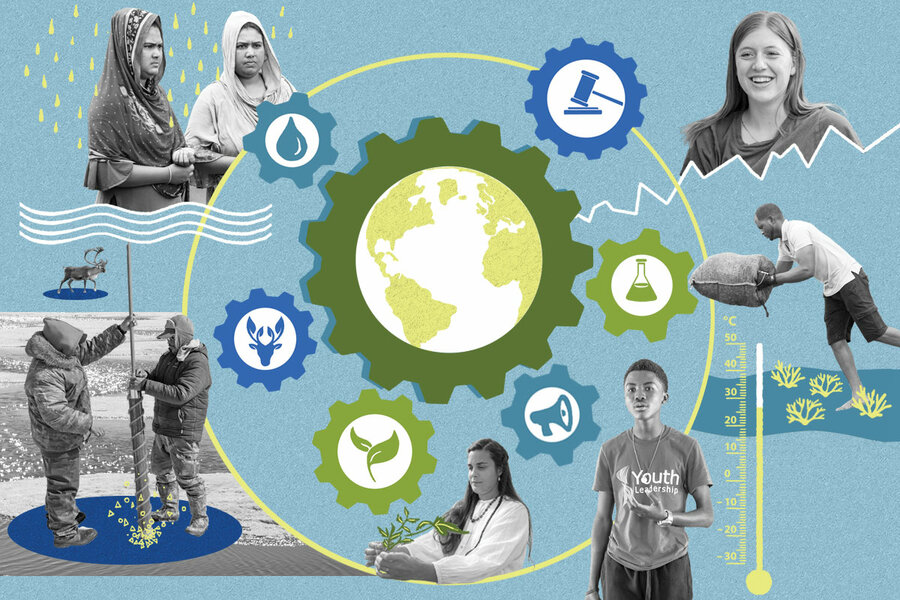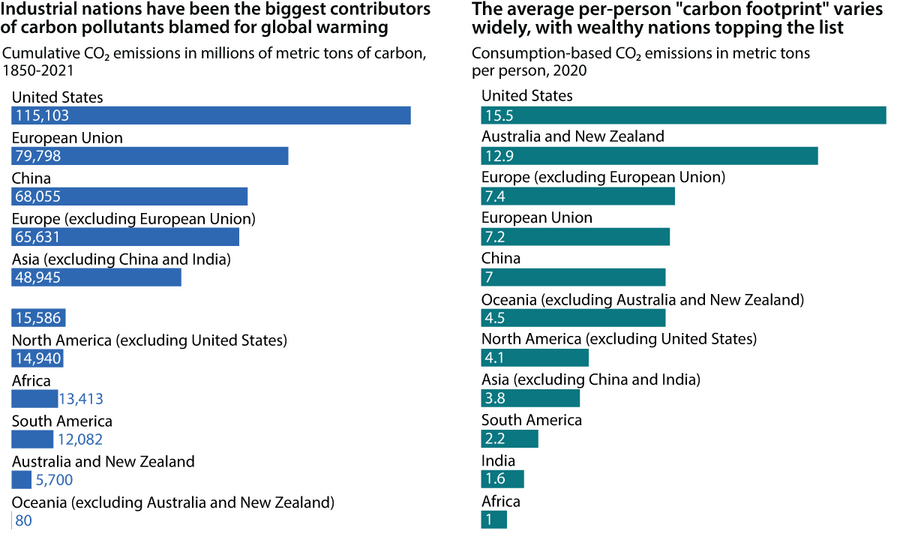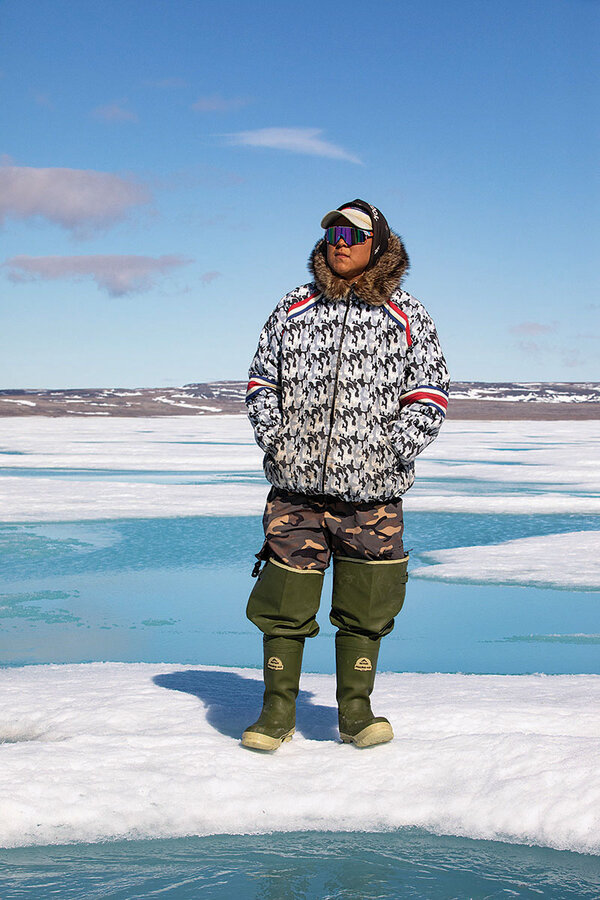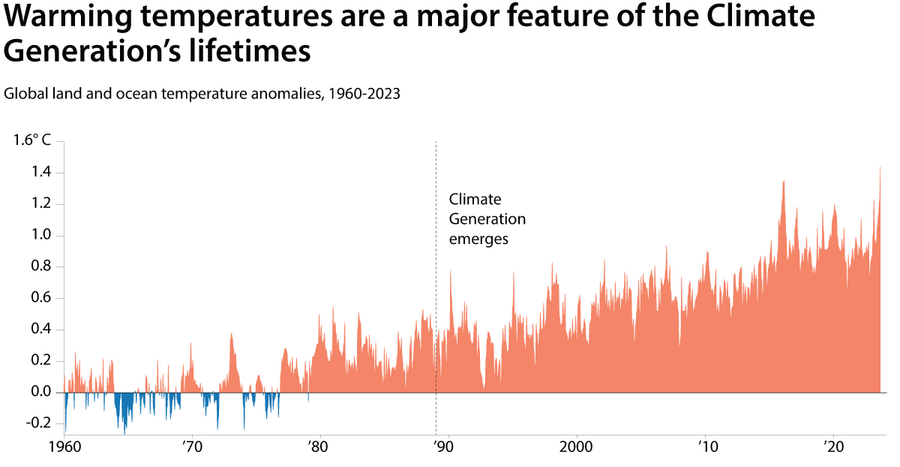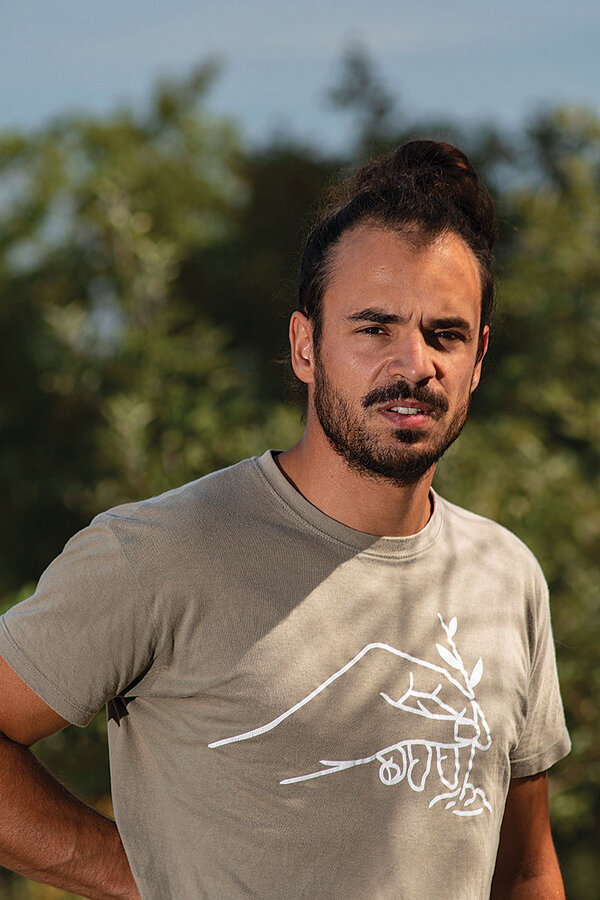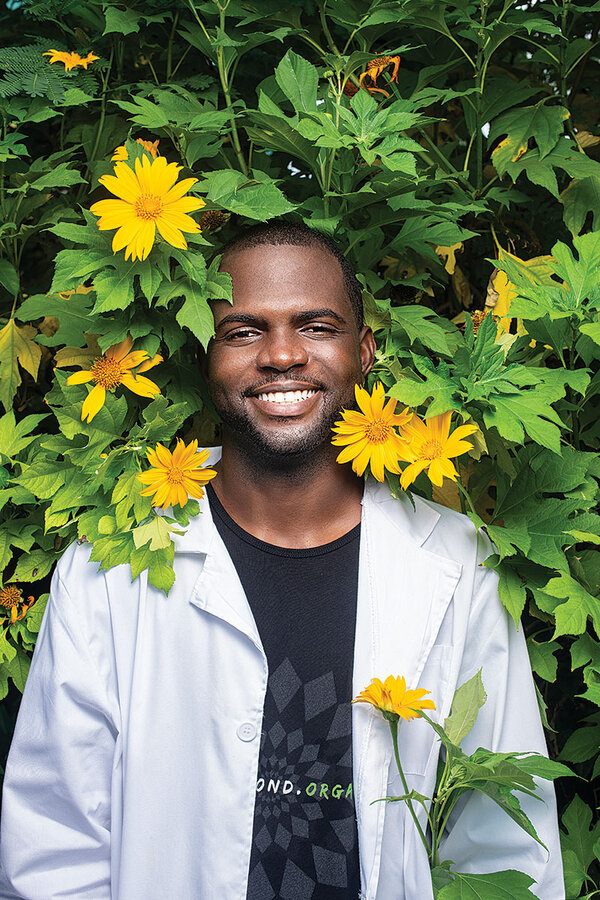Climate change is driving a global youth revolution
Loading...
The Climate Generation looks like Atlas Sarrafoğlu, a Turkish 16-year-old with a shy smile, Nike high tops, and a cardboard sign of accusation: “Your mistakes, our future.” He filed a lawsuit this year against his government, hoping to force the grown-ups to pay attention to the nation’s carbon emissions.
Our Monitor team met Atlas and dozens of young people shaping what it means to live in a world altered by a changing climate. From the gleaming financial capital of Frankfurt to the sea-breeze coasts of Barbados, big-sky Montana to the waterlogged streets of Bangladesh, sunny rural Portugal to the windblown ice of the Arctic, a breathtaking transformation is underway.
Why We Wrote This
A story focused onA spectacularly connected new generation is shaping a global ethos that may well be the most hopeful answer to climate change. A Monitor team traveled the globe to explore this in a seven-part series.
Climate change is fueling a mindset revolution led by a younger generation seizing opportunity in the extremity of the crisis. Spectacularly connected across continents, this Climate Generation – those born since 1989, when children’s rights and climate change began to intersect – is shaping a global ethos that’s possibly the most hopeful answer to the heating planet.
“The solution to the problem is in their hands,” said the late Saleemul Huq, a Bangladeshi expert on climate change and sustainable development, who died unexpectedly just before press time. “While there are many other ways of dissecting this global issue ... the older generation v. the younger generation is by far the most significant one.”
Listen to the full story, read by its editor
The Climate Generation looks like Atlas Sarrafoğlu, a boyish 16-year-old with a shy smile, Nike high tops, and a cardboard sign of accusation: “Your mistakes, our future.” He has it resting next to him by a park bench in Istanbul along the banks of the Bosporus, where growing up he played soccer and listened to rap music.
The sign, in some ways, is the easiest of his protests in his authoritarian-leaning country. Earlier this year, the teen filed a lawsuit against the Turkish government demanding it fulfill the commitment it made, along with most of the world, to lower the amount of heat-trapping gases it sends into the atmosphere.
Why We Wrote This
A story focused onA spectacularly connected new generation is shaping a global ethos that may well be the most hopeful answer to climate change. A Monitor team traveled the globe to explore this in a seven-part series.
Maybe a court action, he hoped, would make the grown-ups pay attention. He knew other young people had tried that in their countries.
Six thousand miles across the Atlantic, Natalie Yocum glances up from the banks of the Bitterroot River and checks out the haze thickening over the mountains north of Missoula, Montana. She inhales.
“It smells like cross-country season,” the 22-year-old says, and then gives a quick, embarrassed laugh. It feels wrong to be nostalgic about smoke. But in the American West, wildfires have burned through childhood.
Ms. Yocum knows from the alerts on her phone that this July 2023 blaze is not contained, and that it is moving closer to where she and her parents live, north of Missoula, in the big-sky town of Arlee, population 592. She once volunteered on a firefighting chain saw crew, and she knows many of the people who are monitoring the situation. But after a quick glance at the horizon, she turns back to measuring water quality. It will take many people doing lots of little things, she believes, like this fieldwork she is doing as a volunteer for a local nonprofit, to slow climate change.
Jakapita Kandanga, a 26-year-old Namibian climate activist, is also working to respond to the world’s increasingly disrupted weather patterns, from floods and droughts to heat waves and fires. She has felt the impact of these changes. During her childhood, when the rains stopped in rural Namibia, Ms. Kandanga’s father couldn’t sell his cattle – and she couldn’t attend school.
She doesn’t want anyone else to ever experience this. That’s why she’s gotten up on a Saturday morning to teach a bunch of children in an informal settlement outside the Namibian capital Windhoek about what climate change is.
“I just want that everybody has equal resources to survive the climate crisis,” she says. Everyone should have access to education, she adds: “Everyone should have the tools to survive.”
We met Atlas, Natalie, and Jakapita this past year, along with dozens of other young people who are shaping what it means to live in a world altered by a changing climate.
Originally, we sought them out because we were interested in a paradox: Today’s young people were born into an unprecedented era of children’s rights, a time when most of the world agrees that young people are entitled to things like a safe home, the ability to go to school, and the freedom from physical harm. Yet at the same time, this Climate Generation, as we are calling it, has come of age in an era of unprecedented challenge, and is confronting the overwhelming reality of a changing, heating, disrupted world.
Both of us have written extensively about children, from many angles and many parts of the world. We are also the mothers of daughters on the cusp of young adulthood. We’d been hearing a lot, personally and professionally, about young people’s mental health struggles with climate change – in and of itself a new phenomenon.
A recent study led by Caroline Hickman, a researcher at the University of Bath in England, shows how youth across the world feel similar levels of eco-anxiety. Almost half of young people in Africa said they have reconsidered having children due to climate change, according to a UNICEF poll.
“The difference is generational rather than [by] countries,” says Ms. Hickman. “And that is stronger than gender ... economic background ... politics – stronger than anything.”
Still, we suspected there was more than gloom and doom to the Climate Generation’s shared experience of a changing world. So, for the past year, the two of us have traveled around the globe to talk to them.
And it turns out there is much more.
From the gleaming financial capital of Frankfurt to the sea-breeze coasts of Barbados, from the big skies of Montana to the waterlogged streets of Bangladesh, from the sunny countryside of Portugal to the windblown ice of the Arctic, a breathtaking transformation is underway.
Climate change is shaping a mindset revolution.
If the Industrial Revolution rippled across the globe and human consciousness with new definitions of progress, time, responsibility, and work, the climate crisis is redefining those conceptions. In our travels, we met innovators and regenerators, activists and adapters, conservationists and challengers. All of them, in their own ways, are pushing back against the silos in which we’ve understood our world in industry, environment, or geography. They are seizing on a crisis moment to tackle the inequalities and injustices that have long saddled their nations – crafting a new ethos about consumption, “progress,” and what it means to have a good life.
We define the Climate Generation as those born in or after 1989, when the United Nations Convention on the Rights of the Child was adopted. It has since been ratified by every country in the world, except the United States.
That year also marked the first time the world surpassed what scientists call a safe concentration of atmospheric carbon dioxide, a heat-trapping gas largely responsible for the warming and related climatic changes we see today.
Individually, the stories of these young people can seem small, like pinpricks of light flickering against a supercharged storm of politics-as-usual, economic and cultural norms, and a global inclination to avoid the realities of climate change. But as we met more people, we realized that very little the Climate Generation does is truly isolated; this is a generation that is spectacularly connected.
A young couple who farms in the dusty interior of Portugal shares what they’ve learned about climate adaptation to an international Instagram following. A young scientist in Barbados working on biofuel production travels to California to work with other young researchers. Atlas, the teen from Turkey, turns out to be friends with the climate activist we wanted to meet in Namibia, who in turn talks about her admiration for the organizer we went to Bangladesh to interview.
And it is this connectedness, researchers say, along with the Climate Generation’s shifts in perspective and behavior, that may well be the most hopeful answer yet to a heating world.
“The solution to the problem is in their hands,” said the late Saleemul Huq, a Bangladeshi expert on climate change and sustainable development, who died unexpectedly just before press time. “And while there are many other ways of dissecting this global issue – North vs. South, rich vs. poor – to me, the older generation vs. the younger generation is by far the most significant one.”
A powerful web of global connection
Social revolutions are as tricky to pinpoint as climate change itself. Think back to when you first started using email or a smartphone, wireless earbuds, Netflix, or same-day delivery. For most of us of a certain age, there was no one day when we woke up and noticed that we were part of a technological revolution. But we were.
Our individual actions – jobs, purchases, preferences, expectations, and mindsets – wove that revolution into the fabric of our collective existence.
Climate change is similar. For decades, scientists have warned about “anthropogenic climate change,” a term we realize is pretty much meaningless to most readers. Even the words “climate change” are often misunderstood or filled with either mistrust or a certain anxiety.
But the technological revolution – once an amorphous, frothy concept itself, laden with dreams and dire forecasts – has now shifted tangible parts of the mundane elements in our lives. Likewise, the environmental disruptions connected to our heating world are also beginning to change our everyday lives.
Sometimes it’s dramatic. This past year saw a cascade of extreme weather events: ice storms in Texas, unusually long-lived cyclones that killed hundreds in southeast Africa, Canadian wildfires that turned New York City opaque, and heat waves that helped make this summer the hottest ever recorded. But it can also be nearly imperceptible: the slow migration of maple trees northward, humidity that lasts a few days longer, storm drains that regurgitate seawater during high tides.
The Climate Generation revolution follows a similar pattern.
There are the individuals who seize headlines and inspire others. Swedish teenager Greta Thunberg captured international attention when she protested outside the Swedish parliament, week after week, throughout the 2018 school year. The international activist group that she inspired, Fridays for Future, would soon motivate many thousands of youth across the world to demand government action in response to their heating world. In September 2019, an estimated 4 million schoolchildren protested during the Global Week for Future.
It’s easy to forget just how big this movement was becoming when the pandemic shut down public gatherings in early 2020.
When we were in high school during the early 1990s, the pinnacle of environmentalism was recycling. We both collected aluminum cans for the school environmental club and occasionally participated in a class stream cleanup. We remember disturbing pictures of landfills and oil spills coating seabirds, but nothing felt particularly existentially threatening.
This, of course, was part of the privilege of growing up white and economically secure in the U.S. Our Generation X contemporaries in sub-Saharan Africa, where Stephanie worked as a foreign correspondent for many years, lived the trauma of unsustainable resource extraction; so did those in Latin America, where Sara spent years as a reporter.
But it is a distinguishing feature of the Climate Generation to recognize a shared ecological harm.
During the pandemic, Ms. Thunberg encouraged young people to take their protests to social media. It was a move that took the youth climate protesters out of the public eye. These new efforts may not have had the made-for-TV drama of marches and live protests, but they built a practice of cross-national communication and connection – the results of which we saw during our reporting.
Atlas was one of the first youth we met for this series. Sara was in Turkey to cover the devastating earthquakes in February that killed at least 51,000 people. She stopped in Istanbul to meet with Atlas in Bebek Park, where he’d held his first climate protest.
Ms. Thunberg’s protests gave him a sense of awe and bravery, he says: “When she went to the parliament of Sweden ... and was there skipping school, climate striking ... I was shocked because she was [15].” He decided then, at age 11, that he, too, would become a climate activist.
It was a lovely sentiment, Sara remembers thinking. But he seemed so young, sitting there with his sign. Young, and also tiny next to his country’s big state apparatus and police force cracking down on protesters, smaller still next to the global complexity, politics, and economics of the climate crisis itself.
Sara wondered what, exactly, this high schooler hoped he could accomplish.
But as we stayed in touch with Atlas and got to know other young activists, we started to recognize they aren’t isolated protesters, but part of a global network.
It was Atlas who first sent us the WhatsApp number of Ina-Maria Shikongo – “Mama Ina,” as she’s known in climate circles – who has mentored young activists at her home in Namibia. It was Mama Ina who motivated the young teacher, Ms. Kandanga, to talk to those children outside of Windhoek about climate resilience. Ms. Kandanga, in turn, pointed us to Farzana Faruk Jhumu, a UNICEF youth climate advocate we met in Dhaka, Bangladesh.
They are part of an international web that is larger than many older people realize. And it’s one that many scientists feel is key to ushering in the changes they demand the world implement.
Climate scientist Myles Allen from the University of Oxford says he hopes their idealism doesn’t run aground as it did for so many protesters of the 1960s. “It’s important that although they’re activists they don’t settle for protest,” he says. “The hope is that they’ll keep this understanding of what’s going on with them as they actually enter into decision-making roles in government.”
“I don’t love the word ‘activist’”
Grace Gibson-Snyder looks something between exasperated and pained when asked if she considers herself a climate activist. A teenager, she is one of 16 young plaintiffs who won a landmark court decision last summer in a lawsuit claiming the state of Montana violated their constitutional rights to a healthy environment when it directed agencies not to consider potential climate impacts in setting energy policy.
“I don’t love the word ‘activist,’” Ms. Gibson-Snyder told Stephanie with a cringe at a coffee shop in mountain-chic Missoula, Montana. “I’m still struggling with that. ... [Lawsuits are] a very pro-institution way of working through this. ... We’re just saying the government should do what it’s supposed to do. To follow the constitution. It’s pretty simple.”
We heard that a lot. Look at it through one lens, and climate change is complex – an acronym-and-number stew of atmospheric science and integrated earth systems, of ocean currents and tipping points and parts per million and feedback loops.
It’s also, in some ways, pretty straightforward: The world’s getting hotter. We should stop heating it.
The people elected to protect citizens should just start making decisions to protect citizens, many youth told us. Which means, they say, that those leaders should just stop adding to the problem with fossil fuels. In 50 years, some told us, a historian might look back at all the squabbling and hand-wringing and broken governmental promises and see a mind-boggling lack of common sense.
But this is a mindset, we thought, that only comes with a cohesively shared understanding of reality. And, for the most part, the Climate Generation has this when it comes to global warming.
Sixty percent of young Americans – Generation Z and millennials – say that they are alarmed or concerned about climate change, according to the Yale Program on Climate Change Communication, which for years has been tracking public perception about the issue.
Internationally, though, the number is higher – as close to universal as one can get. A global survey conducted by the advocacy group Plan International found that 98% of youth ages 15 to 24 are worried about climate change. And this shifts the generation’s choices in everything from what they eat to where they work.
Statistics show that 20% of people ages 18 to 24 in Britain don’t eat meat – primarily because of climate concerns. And in the broader United Kingdom, a fifth of children age 5 to 16 are vegan or want to be.
In Europe, many are “climate quitting,” as young people eschew working for automobile or energy companies to better align their work lives with their environmental values.
“Saying like, ‘I love this place, but what you’re doing is wrong,’ that is climate quitting. They are done, which is good for us,” explains Anne Kirmse, the head of human resources for Enviria, a startup helping German companies go solar. Sara chatted with her in Frankfurt, the banking capital of the European Union.
Not everyone has the ability to make such choices – and the Climate Generation realizes this.
The Climate Generation in the Global North is acutely aware of its carbon footprint – that it is using more than its share of the world’s resources. In other words, younger people – still so close to those basic kindergarten lessons of sharing and not taking more than one’s fair portion – understand there’s only so much greenhouse gas that can still be put into the atmosphere without causing ecological disasters. Divide that amount of gas by the number of people in the world, and that’s the fair amount of emissions – the size of the carbon footprint – that each individual should cause.
But in European nations, the U.S., and other wealthier countries, individuals emit far more than their share, largely because of their lifestyle habits of driving, flying, buying, and eating. In the U.S., for instance, using 2020 numbers, the average carbon footprint is about 16 tons – compared with the 4.5-ton global average that year, according to Climate Watch, an open data platform focused on climate statistics. In Germany, it is 8.19 tons. In Bangladesh, it’s 1.36. Many researchers say that to prevent the worst effects of climate change, the number should be, on average, 2 tons per person.
“I think about my responsibility for this because of my consumption – that people suffer because of my life standards in Europe,” says Daphne Hübsch, an 18-year-old from Frankfurt.
This isn’t just theoretical for Daphne. She has friends and peers from the Global South – in large part because of her new involvement as a climate activist.
Many young people from the Global South – in the Caribbean, Africa, and southern Asia – talked to us about their desire to have more power and voice, too.
When people in the Global North talk about the Global South, says Ms. Jhumu, the UNICEF advocate, it is “always that ‘they’re the most vulnerable. They don’t know how to cope with this, so we need to support them.’”
But, she adds, “we want to shift the narrative. We don’t want to show the world that we are finished, that we are doomed. We want to show there is hope and many solutions are already there.”
Likewise, Naomi Cambridge, a 21-year-old activist in Barbados, talks of how important it is for young people from small island nations to be heard on the international stage: “We are extremely vulnerable on a different level [than most people realize].” To build the best global solutions, she argues, power brokers must understand the perspective of young people in these places.
Inculcating a “green ethos” beyond the easy answers
Revolutions, we learned, can be quiet, almost imperceptible in the day-to-day.
While she was reporting in Montana, Stephanie spent a day following Ms. Yocum and her colleague, Bri Fain, as they tested river quality around Missoula. The 22-year-olds chatted about the pros and cons of roommates, about weekend rafting trips, the Bonnie Raitt concert they couldn’t afford, college classes, and moms tracking their children’s locations via iPhone.
They also both wondered aloud whether they’d feel right having their own children, given the changing climate.
That matter-of-fact sentiment struck us. So did their incongruously bubbly assertions that a sustainable world requires changes, but that it sometimes feels overwhelming to know what to do about it.
The young women don’t like the pattern of American consumption – but admit being tempted by the shiny objects on Instagram. They care about the fossil fuel load of what they eat but aren’t convinced of the easy answers of veganism or vegetarianism. They express a deep respect for Indigenous perspectives and practices and see humans as just one part of an ecosystem – the sort of mindset we saw in practice when Sara visited young members of the Indigenous Guardians of the Canadian Arctic.
They think the idea of never-ending expansion and consumption is ludicrous, as much part of a passé era as black-and-white television or cable. Like the young Portuguese farmers we met, they believe that smaller is better. Less is more.
They were, it seemed to us, mainstream representations of ideals that may have once seemed radical becoming the norm.
We wondered what this would mean for the youngest of the Climate Generation, those children born when the understanding of our future has already shifted.
At a tiny community garden, two dozen 4- and 5-year-olds from an impoverished neighborhood of Dhaka collect leaves and petals that have fallen to the muddy ground at the end of the rainy season and return to their one-room nursery school to make collages.
This “green play lab,” where plastic toys are getting phased out for those fashioned out of jute, bamboo, and clay, is in part an intentional effort to foster a “green ethos,” but it’s just as much a lesson about progress, explains Asif Saleh, executive director of BRAC, the nongovernmental organization behind the idea. “In a sense we all got kind of brainwashed a little bit by this Western consumerism, the whole notion was that prosperity and modernity means consumption and spending.”
But, “going back to the basics,” as he puts it, in this country that is among the world’s most affected by climate change, is their path to claim their right to a future. And it might be dawning here earlier because of geography, but the lesson applies globally. This year, after all, is shaping up to be the hottest ever recorded.
“For this generation,” he says, “there is no other alternative.”
This article was reported from Bangladesh, Barbados, Canada, Germany, Namibia, Portugal, Turkey, and the United States.





